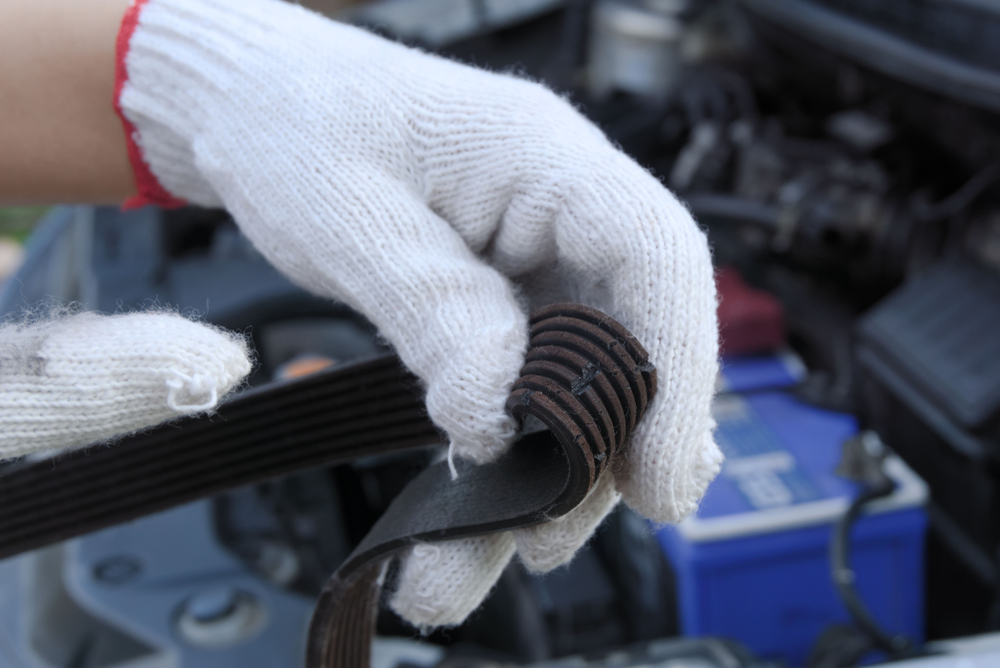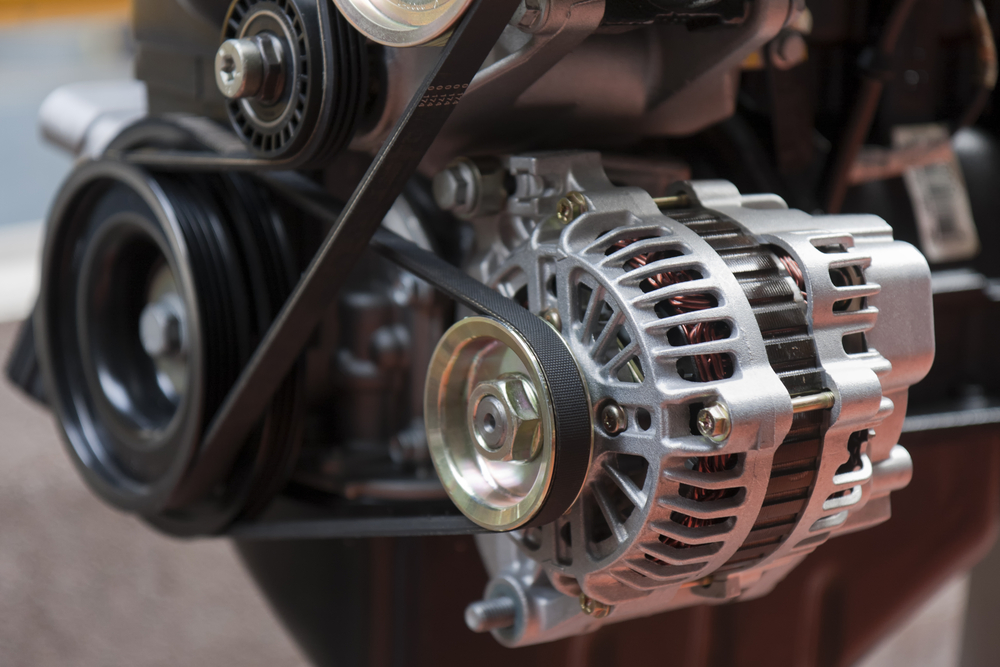At some point, we’ve all heard the loud, high-pitched sounds associated with a loose alternator belt, whether it comes from our car or someone else’s. A loose alternator belt, or serpentine belt, has the potential to cause a wide range of issues in your car, so if you think you may be experiencing this issue, you should take action as soon as possible. You may also hear alternator belts referred to as fan belts because it connects components like the fan, air conditioner, and cooling system.
There are several ways to diagnose a loose alternator belt yourself and many symptoms to look out for if you are trying to rule it out as a possibility. Some of these signs include a battery warning light, blinking lights, and a dead battery. A bad alternator belt can even make your car stall. Thankfully, replacing the belt or tightening it doesn’t have to be a challenge. It comes down to installing the new belt over the engine pulleys on the way that your vehicle instructs you to put on the sticker under the hood.
Read on to find out everything you need to know about the signs of a loose alternator belt, the steps to replace one, and how much they cost to replace.
What Is an Alternator Belt and Why Is It Important?
The alternator belt can also be referred to as the serpentine belt, fan belt, or drive belt. It shouldn’t, however, be confused with the timing belt.
The alternator belt connects your alternator, power steering pump, air conditioning compressor, and water pump to your battery; it transports energy from the engine toward the alternator, which in turn powers the battery. This set of electrical reactions is necessary to charge your battery while you drive, keeping your car running and the other electrical functions of your vehicle in check.
Without a properly functioning alternator belt, your car’s battery will not have enough power to keep moving, leading to issues with the air conditioning, stalling, electrics, and ultimately, a car that just won’t start.
Symptoms of a Loose Alternator Belt
If you suspect you have a loose alternator belt, check out this list of symptoms to help you diagnose the problem. Below, we list the symptoms of a loose fan belt:
- Flickering headlights
- No air conditioning
- Squealing sounds
- Engine overheating
- Bad battery
- Dashboard warning lights
- Engine stalling
- No power steering
- Burning smells
- Loose alternator bolts
More about each of these issues is below.
Flickering Headlights
If you’re driving along and notice your headlights flickering or dimming occasionally, the culprit could be a loose alternator belt. Without the belt working properly, there will not be enough electricity reaching your battery to power the lights correctly.
Other causes of this issue include a bad battery or an alternator that is on its way out. In this instance, it is a good idea to confirm other symptoms of a loose alternator belt so that you know how to proceed with a repair.
No Air Conditioning
Because the alternator belt is often in charge of keeping your air conditioning system functional, no cool air, once you turn the air conditioner on, could indicate that there is an issue with the alternator belt.
Squealing Sounds
One of the most recognizable signs of a loose alternator belt is the high-pitched squealing sound that accompanies it. If you are hearing this sound coming from the front of your car, there is a good chance your alternator belt is loose and needs to be realigned, or the belt is completely damaged and needs to be replaced.
Engine Overheating
The alternator belt will activate the water pump when it is working correctly; if the belt has slipped off or is otherwise not working right, the water pump will not activate. This leads to your engine overheating because it is not being cooled down like normal.
Check the temperature gauge on your dashboard to keep an eye on your engine’s temperature, and don’t let an overheating engine go unaddressed; allowing this issue to continue could cause more extensive, expensive damage to your vehicle down the line.
Bad Battery
Because the alternator belt is designed to power the battery, a faulty battery is a great indicator that you are having issues with a loose belt. If you are driving and suddenly lose power, if your car refuses to start, or if you replace the battery only to experience the same issues, a loose alternator belt is likely the culprit.
You’ll also notice that the alternator belt will hurt the charging voltage. Your battery should sit at around 12 or 13 volts, but a bad alternator can cause the battery to slowly lose power. If you just installed a new battery and the voltage starts dropping into the 11-volt to 10-volt range, it’s a sign of a loose alternator belt.
Dashboard Warning Lights
On your car’s dashboard, there is a small symbol that looks like a battery. This symbol will illuminate when the car detects an issue with your battery that could be caused by several things, including a loose alternator belt.
Engine Stalling
Engine stalling is related to the issue of a bad battery. If your engine suddenly stops working while you are driving, it can be quite a dangerous issue, so you should check on your alternator belt as soon as possible.
No Power Steering
The alternator belt also controls the power steering functions; if you notice that it starts to become hard to turn your steering wheel, your car is hard to control, or your car does not follow when you turn the wheel, a loose alternator belt may be the reason.
Burning Smells
When the alternator belt is loose or misaligned, it will likely cause friction on the other parts of your car engine. This will result in a burning smell that can start in your engine and come through your air conditioning vents. This will be the distinctive smell of burning rubber, which is what most alternator belts are made out of.
Loose Alternator Bolts
A loose alternator belt can also cause bolts to loosen because of a reduction in pressure. This can cause your alternator to feel shaky or begin to vibrate. Loose alternator bolts can also be a sign of a belt that’s too tight, so make sure you check your alternator belt when you notice a shaky or vibrating alternator. Signs of loose bolts may also include loud noises.
What Are the Symptoms of a Tight Alternator Belt?
We know that a serpentine belt can be too loose, which leads to problems. But what if the alternator belt is too tight? In this case, you’ll experience different symptoms that can damage your vehicle.
We list the most common symptoms of an alternator belt that’s too tight below.
- Excessive loads that can overheat your engine’s bearings and bolts, which causes loud noises and a reduction in performance
- More pressure on bearings and pulleys causes premature wear
- The alternator belt will wear down faster
- The battery and alternator may not properly charge
The dashboard might also display a voltage or ignition warning light. This can also be a check engine light in some cases, so it’s best to read the code with a scanner.

How to Check on Your Alternator Belt
To properly diagnose the cause of your car troubles as being due to a loose alternator belt, you should know where to look for the belt and what to look for.
In most vehicles, the alternator belt is located at the front or the side of the engine. The exact location depends on the make and model of your car. The belt should be wrapped around the cylindrical alternator and be pulled taught; if it is hanging loose or not properly wrapped around the edge of the alternator, your issue is resulting from a loose belt.
To check the tension in the belt, you will need to grab a ruler and find the exact middle of the belt on its longest side between the pulleys. Grab this center point and try to move the belt; if it moves more than half of an inch, it is too loose. If it moves much less than that, it is too tight. You can check the exact specifications for movement on your alternator belt in the vehicle owner’s manual.
Alternatively, all of the symptoms we discussed above could also be the result of a damaged alternator belt. If you examine the belt and it appears to be in the correct place and sitting snuggly, take a closer look at it. Any sign of wear, cracks, damage, or a dried-out belt means that the belt needs to be replaced.
If there are large chunks or gashes taken out of the belt, there could be something in your engine that is rubbing on the belt and damaging it; this should be investigated before you replace the alternator belt to prevent immediate damage to your new belt.
Replacement Cost for an Alternator Belt
A loose alternator belt has slipped out of its proper place and is not functioning properly. This can happen naturally over time due to normal wear, or it could be because the belt is damaged and needs to be completely replaced. If the belt has just slipped out of place, a realignment or tensioning will likely fix the issue. We have listed the costs for both scenarios below.
Alternator Belt Adjustment
An adjustment to your alternator belt is a relatively simple fix and will not cost too much.
Luckily, if your belt just needs to be tightened up, you will only have to pay for labor costs instead of also purchasing new parts. Labor can range between 40 and 150 dollars an hour, and this adjustment usually won’t take more than an hour unless the alternator belt is particularly difficult to locate or other issues with your alternator are causing the belt to move out of place.
Keep in mind that unless your alternator belt is brand new without any signs of wear, it may be a better idea to go ahead and replace it. This will prevent you from experiencing alternator belt issues shortly and will take care of the existing problem of the belt slipping off at the same time.
Alternator Belt Replacement
If your loose alternator belt is too worn out to simply tighten up, you will need to have it replaced. This can add more cost to the repair as you will need to purchase the part in addition to paying for the installation labor.
The cost for an alternator belt alone is between 25 and 100 dollars depending on the kind needed for your vehicle. Labor costs remain the same at between 40 and 150 dollars per hour, so you can expect the replacement to cost you anywhere between 95 and 250 dollars on average, if there is nothing else wrong with your car’s overall alternator system.
Fixing Your Alternator Belt at Home
If you’re looking to save on repair costs, you can either tighten up or completely replace your alternator belt at home. For this process, you will need a ruler, a pry bar, a screwdriver, and gloves to protect your hands.
Tightening a Loose Belt
- To tighten a loose belt, you should first measure how loose the belt is using your ruler. You can skip back to our section above for instructions on how to do this.
- Once you know roughly how loose the belt is, locate the drive belt tensioner. It will be found either on the alternator itself or on a pulley, depending on the car you have. There should be one bolt that holds the belt in place and allows it to pivot, and a slotted slider on the other end that allows for belt-tightening.
- Loosen the pivot bolt to allow for some movement, then insert the pry bar above the alternator pulley. You should apply gentle pressure in an upwards motion to add tension to the drive belt.
- After you have added tension to the belt, tighten the bolt slightly to lock it into place.
- You should then test the tension again; if it is within the half-of-an-inch movement range, you can tighten the pivot bolt fully and start the engine to ensure everything sounds smooth.
- If the belt is still too loose or even too tight, repeat the process until the belt is adjusted correctly.
- For this adjustment, you will not need to pay much, as you are performing the labor yourself, and you will not need to purchase anything unless you need a specific tool. If you need help visualizing this process, check out this video.
Replacing a Damaged Belt
A damaged alternator belt can be replaced fairly easily. You will need most of the same tools that you use in tightening a loose belt, and the process involves completely unscrewing the pivot bolt so you can remove and replace the belt. A detailed guide for this replacement process can be found here.

Frequently Asked Questions
What Causes a Loose Alternator Belt?
There could be several things contributing to your loose alternator belt, including a faulty automatic tensioner, oil leaks, or a misaligned belt pulley.
Some of these issues may need to be dealt with before you tighten a loose belt, as they are the root cause of the problem; if you suspect that anything other than normal wear and tear has caused the alternator belt to slip loose, you may need to consult a professional.
Is It Safe to Drive With a Loose Alternator Belt?
While you may be able to make it short distances driving with a loose alternator belt, it is not a good idea to keep driving with it in this condition. You run the risk of your battery dying and engine stalling while you are on major roads, which can be extremely dangerous. Not to mention, if the power steering in your car goes off, you may not be able to control your car’s trajectory properly.
If you are experiencing any of the symptoms of a loose alternator belt, stop driving as soon as possible and make an effort to diagnose and fix the problem yourself, or take your car to a professional.
How Often Do Alternator Belts Need to Be Replaced?
Depending on environmental conditions and the brand of your alternator belt, it should last you between 60,000 and 100,000 miles before needing to be replaced. It is a good idea to check on the status of your belt during oil changes or regular tune-ups to determine if there is any damage and that the belt is at its correct tension.
Does a Loose Alternator Belt Impact Acceleration?
Yes, a loose alternator belt will impact acceleration. In fact, you’ll lose acceleration because the alternator may not provide enough power to your vehicle’s fuel pump. With less power to the fuel pump your engine will misfire and a reduction in acceleration will occur.
Can I Drive with a Loose Serpentine Belt?
You shouldn’t ever drive with a loose serpentine belt. That said, you may be able to make it small distances with a loose belt. The risk of driving with a loose serpentine belt is that the alternator may slip, which can cause a power reduction from the water pump and a power increase from the battery. This can drain your battery and cause your vehicle to overheat if the water pump isn’t spinning fast enough.



